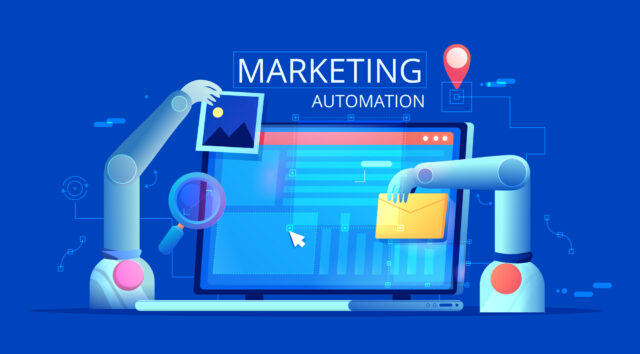In today’s fast-paced digital landscape, marketers are constantly seeking innovative ways to streamline their processes and enhance customer engagement. Machine learning (ML) has emerged as a powerful tool for automating various marketing tasks, enabling businesses to optimize their strategies and deliver personalized experiences at scale. Here’s a comprehensive guide on how to leverage machine learning for marketing automation effectively.

Marketing Automation. Computer with a site that builds the robot’s hands. Vector flat illustration.
1. Understanding Machine Learning in Marketing
Before diving into practical applications, it’s essential to grasp the basics of machine learning. ML is a subset of artificial intelligence (AI) that allows systems to learn from data, identify patterns, and make decisions with minimal human intervention. In marketing, ML can analyze vast amounts of consumer data to provide insights that drive automated processes, from customer segmentation to content recommendations.
2. Customer Segmentation
One of the primary applications of machine learning in marketing automation is customer segmentation. Traditional segmentation methods often rely on demographic data, which may not accurately reflect customer behavior. ML algorithms can analyze various data points, including browsing history, purchase behavior, and engagement metrics, to identify distinct customer segments.
Implementation:
- Use clustering algorithms (like K-means or hierarchical clustering) to group customers based on their behaviors and preferences.
- Create targeted marketing campaigns tailored to each segment, ensuring that messaging resonates with specific audience groups.
3. Personalized Content Recommendations
Personalization is key to effective marketing, and machine learning can significantly enhance content recommendations. By analyzing user behavior, preferences, and interactions, ML algorithms can suggest relevant products or content, increasing the likelihood of conversion.
Implementation:
- Utilize collaborative filtering or content-based filtering techniques to generate personalized recommendations for customers based on their past behaviors and preferences.
- Implement recommendation engines on your website or email campaigns to suggest products, articles, or services tailored to individual users.
4. Predictive Analytics for Lead Scoring
Machine learning can also improve lead scoring, allowing marketers to prioritize leads based on their likelihood to convert. By analyzing historical data, ML algorithms can identify patterns that indicate high-potential leads.
Implementation:
- Train ML models on historical lead data, considering factors like engagement level, company size, and industry.
- Use the insights to create a lead scoring system that ranks leads, enabling your sales team to focus on the most promising prospects.
5. Automating Campaign Optimization
Marketing campaigns require constant monitoring and adjustments to maximize effectiveness. Machine learning can automate this process by analyzing performance data and making real-time adjustments.
Implementation:
- Use reinforcement learning algorithms that adapt marketing strategies based on real-time performance metrics, such as click-through rates and conversion rates.
- Implement A/B testing at scale, allowing ML algorithms to identify the best-performing variations and optimize campaigns accordingly.
6. Enhancing Customer Interactions with Chatbots
Chatbots powered by machine learning can automate customer interactions, providing instant support and personalized recommendations. These bots can learn from user interactions to improve their responses over time.
Implementation:
- Integrate ML-based chatbots on your website or social media platforms to handle common inquiries, recommend products, and guide users through the purchasing process.
- Monitor chatbot interactions and gather feedback to refine and improve the bot’s performance continuously.
7. Predictive Customer Retention
Retaining existing customers is often more cost-effective than acquiring new ones. Machine learning can help predict churn by identifying customers at risk of leaving and enabling targeted retention strategies.
Implementation:
- Analyze historical customer behavior to build models that identify patterns leading to churn.
- Develop tailored retention campaigns, such as personalized offers or re-engagement emails, for customers predicted to churn.
8. Measuring Marketing Performance
Machine learning can enhance the way marketers measure and analyze campaign performance. By automating data collection and analysis, ML can provide deeper insights into what works and what doesn’t.
Implementation:
- Use ML algorithms to analyze key performance indicators (KPIs) across multiple channels, allowing for a holistic view of marketing effectiveness.
- Implement automated dashboards that provide real-time insights into campaign performance, enabling quick decision-making and strategy adjustments.
Conclusion
Incorporating machine learning into marketing automation is no longer a futuristic concept; it’s a practical necessity for businesses looking to stay competitive. By leveraging ML for customer segmentation, personalized content recommendations, predictive analytics, campaign optimization, chatbots, customer retention, and performance measurement, marketers can streamline their processes and enhance customer experiences.


No responses yet